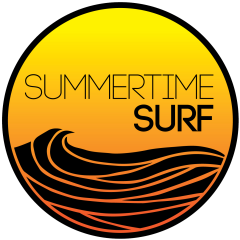BEGINNER MISTAKES

Beginner Mistakes
While Learning to Surf
When embarking on a new journey, whether it be learning a skill, starting a hobby, or venturing into a new field, beginners often encounter certain pitfalls that can hinder their progress. Recognizing and avoiding these common errors can streamline the learning process and lead to greater success and satisfaction. The same goes for learning to surf. If we ask ourselves, “what are the most common errors that beginners make?” you can expect answers like:
- Starting on the wrong equipment (usually too small).
- Learn more about finding the right board for you. Summertime Surf Quiver explained.
- Trying to learn ONLY by trial and error (vs a mentor or lessons).
- Underestimating the importance of paddling.
- Not paying attention / understanding / respecting the ocean, not observing conditions before jumping in.
- Being overconfident when they should be humble.
- Being under confident / timid when they should be committed / charge.
- Trying too hard. Paddling too hard (flailing).
- Not trying hard enough. Not paddling hard enough (commitment when catching waves)
- Looking down (at the board) instead of at the beach / ahead to where they are going.
- Starting to paddle too late.
- Not bending knees when standing.
- Leaning too far forward (instead of bellybutton / center of gravity over center of board).
- Trying to “force it” instead of being fluid with motions.
- Stop paddling (having no momentum) when a big wave is coming instead of paddling as fast as you can to punch through it (or at least not get turned around / pushed back to the beach). There is a systematic process that’s actually pretty simple.
If you take a step further, you’ll also discover that the social aspect of surfing influences beginners just as much, if not more, than the technical elements of the sport.
- There’s also the factor of respecting other surfers, surfing within your ability level, learning and knowing where and how to position yourself in the lineup / which breaks to surf at (and not to) while you’re a novice etc. Youtube “Surf Etiquette”-you’ll get the basics.
- Getting caught up in “being good” / looking cool / getting video / clips to share on social media instead of being present, simply having fun, and surfing for yourself (instead of anyone else).
Becoming a “pro” takes time and dedication. As with any skill, practice makes perfect. The more you repeat the actions with proper form and guidance, the more proficient you will become. Embrace challenges as opportunities for growth, and don’t be afraid to step out of your comfort zone. These milestones will keep you motivated and remind you of how far you have come. Remember, every expert was once a beginner, and perseverance is key to achieving your goals.
Check out below what progression can look like:
Ultimately, surfing is about connecting with the ocean and embracing the joy of the ride. It’s important to cultivate patience and perseverance, as mastery comes with time and practice. Remember to celebrate small victories along the way and learn from every wipeout, as each experience contributes to your growth as a surfer. Stay humble and curious, always open to learning from others, whether through watching more experienced surfers or seeking guidance from instructors.
Above all, cherish the moments you spend on the water, the friendships you form, and the lessons you learn from the waves. Surfing is not just a sport but a lifestyle that encourages mindfulness, respect for nature, and a sense of community. By focusing on these values, you’ll find that the journey is just as rewarding as the destination.
